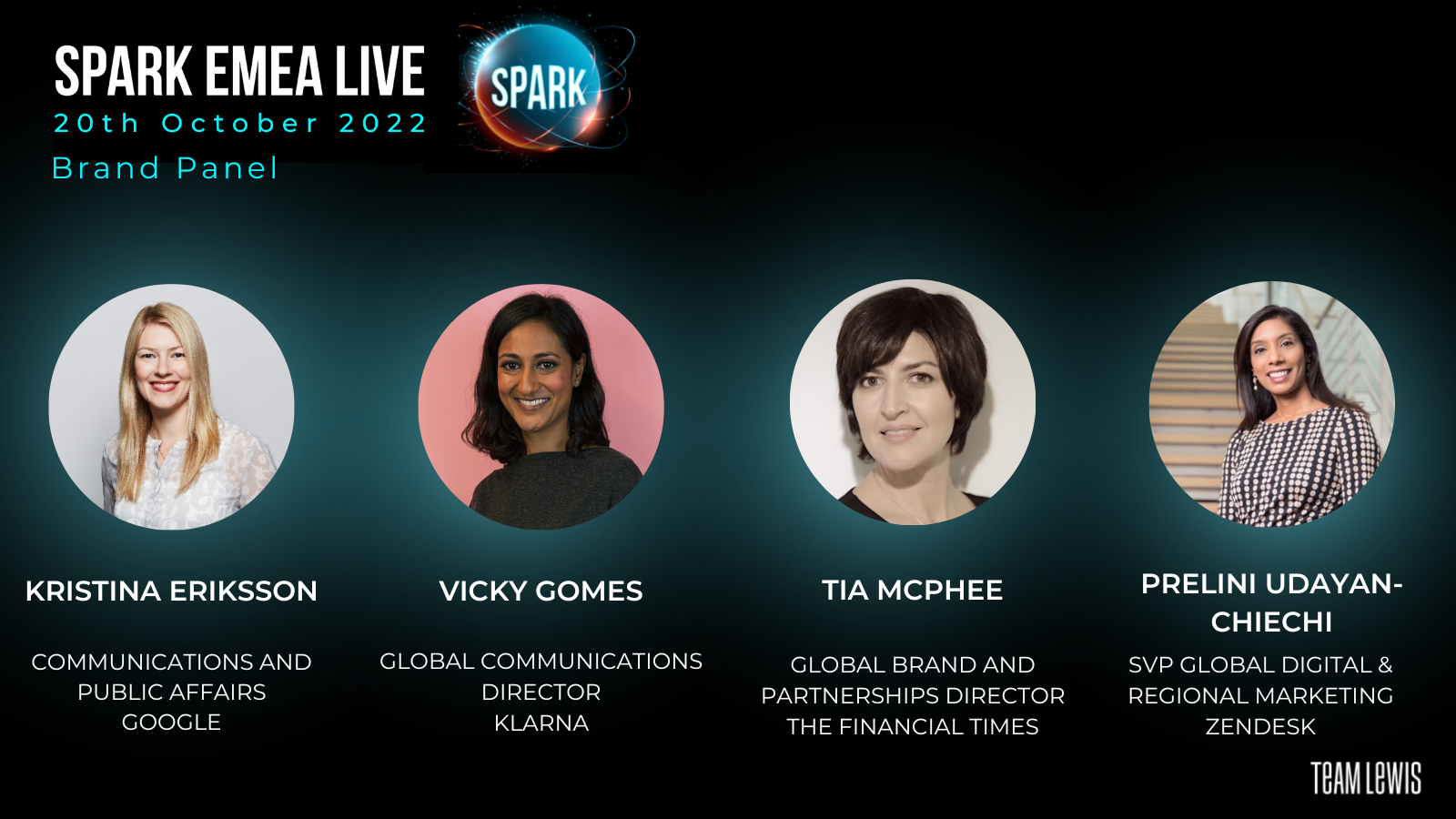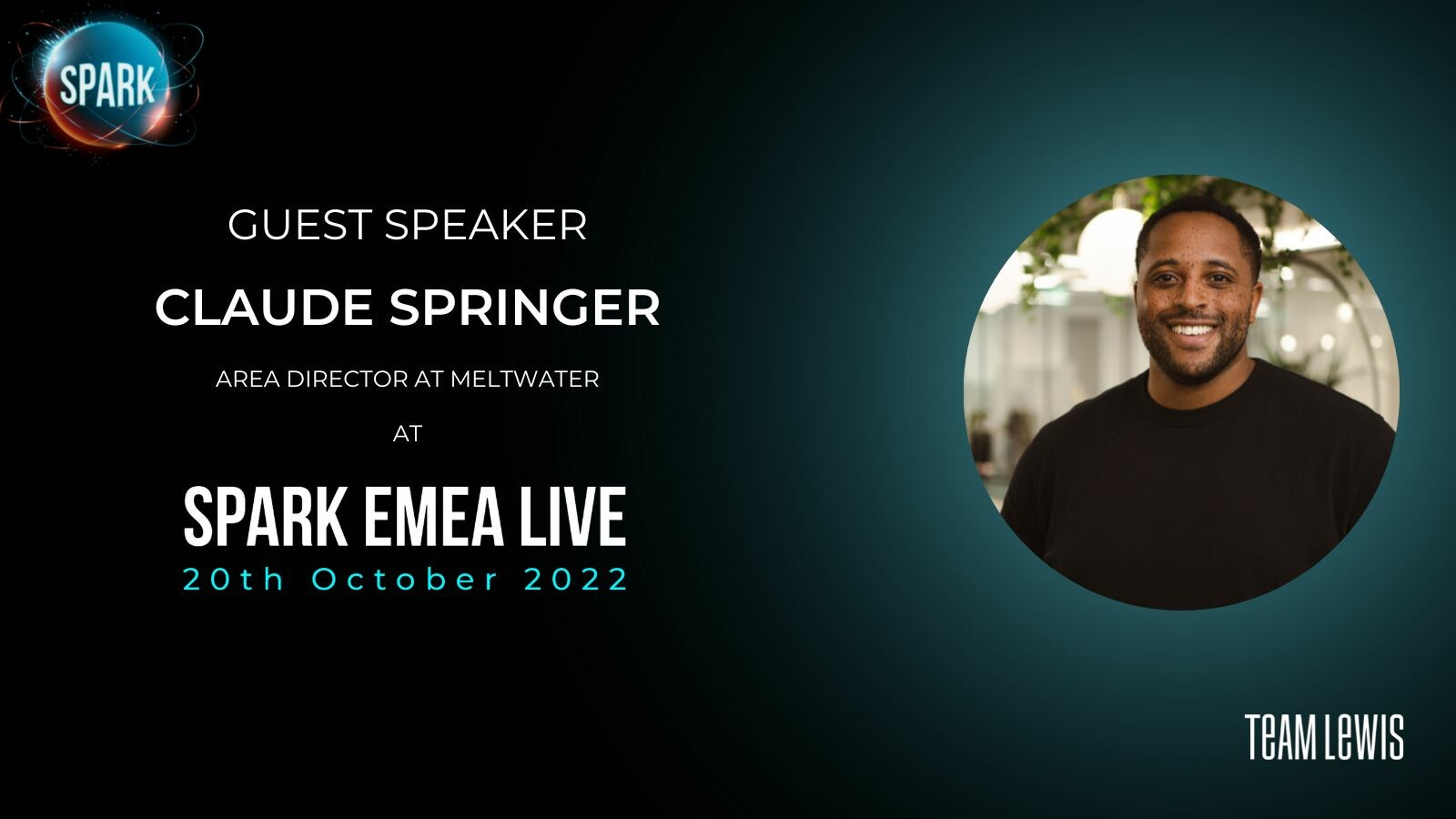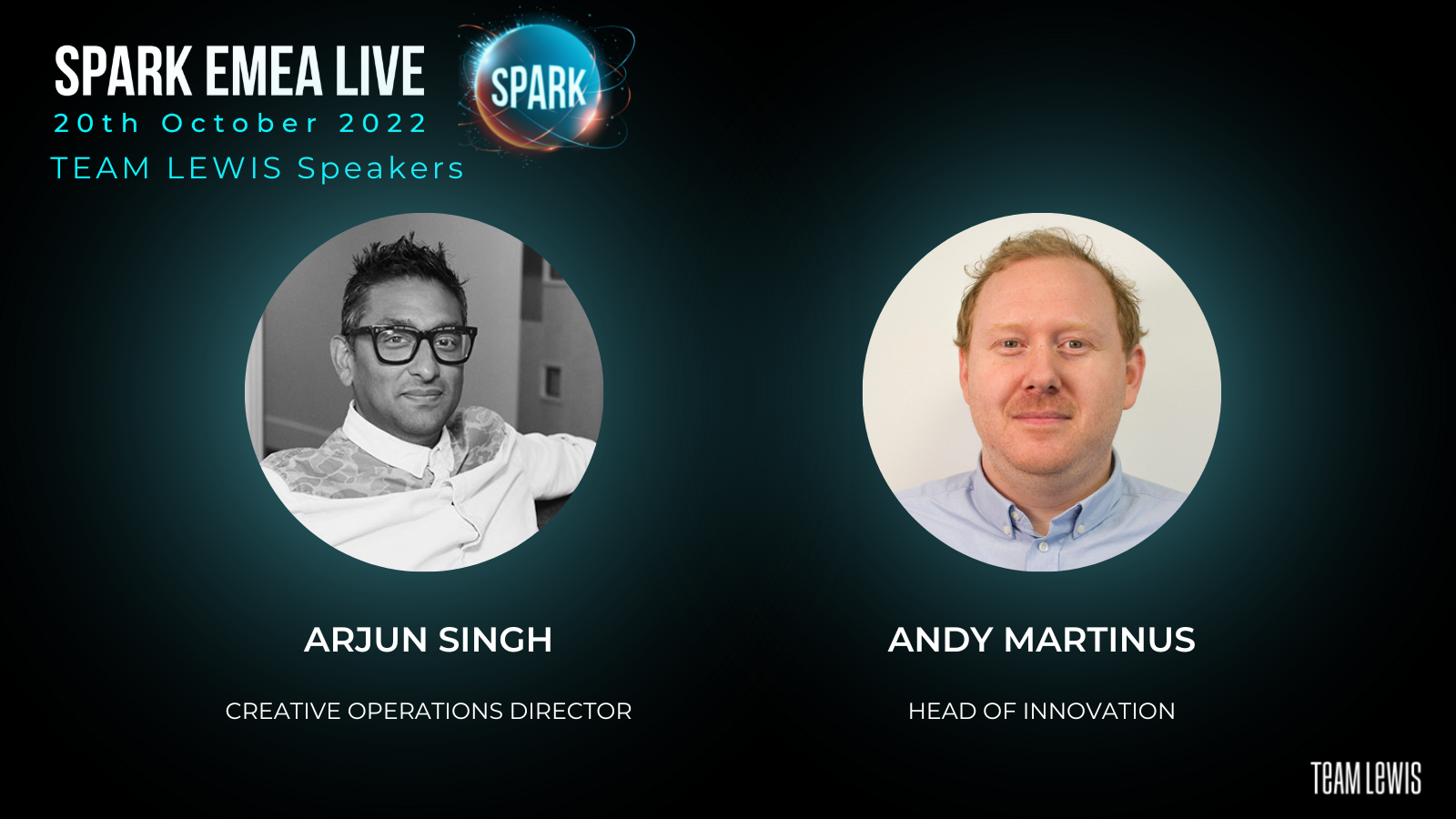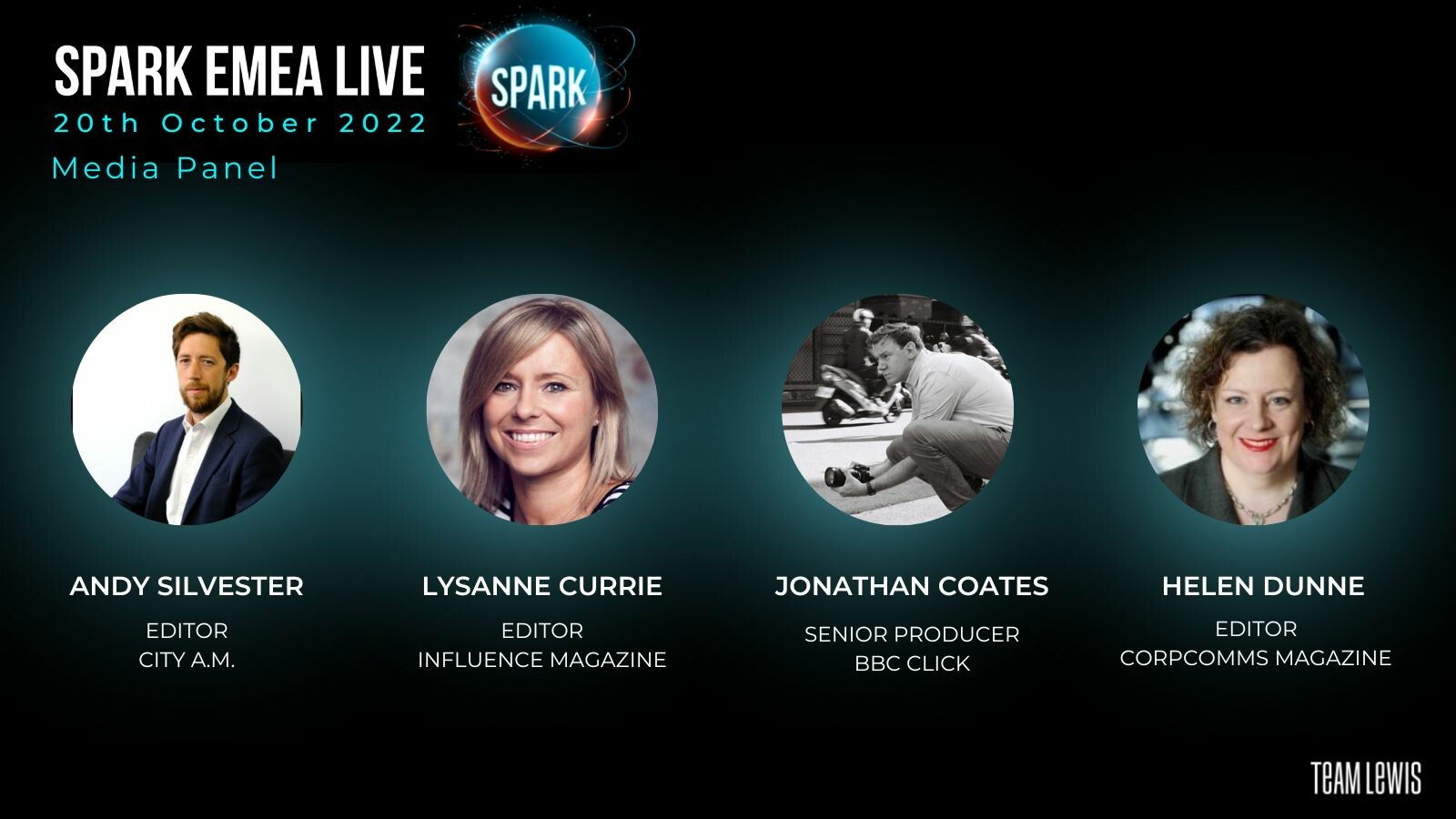SPARK EMEA Live, the follow up to our virtual SPARK client experience summit held in June, explored how brands can navigate uncertain times ahead and tackle the most present and pressing challenges looming on the horizon.
The morning session explored hot topics like economic uncertainty and political unrest and how they impact brands. If you missed it, don’t worry! Read on to find out the top takeaways from each session.
Brand Panel: Marketing your brand in a recession

Host: Yvonne van Bokhoven (Executive Vice President, EMEA & APAC, TEAM LEWIS). Panelists: Kristina Eriksson (UK Internal Comms Lead, Google), Vicky Gomes (Global Communications Director, Klarna), Tia McPhee (Global Brand and Partnerships Director, The Financial Times), Prelini Udayan-Cheichi (Senior Vice President, Global Digital & Regional Marketing, Zendesk)
Our Brand Panel were the first to take the stage at SPARK EMEA Live. The panel shared their advice on how brands can tackle a crisis. Exploring topics like economic uncertainty and political disruption, the panel agreed that smooth crisis management must consider a host of elements. Often the most creative and innovative thinking comes from times of struggle. Here are some of the outcomes from the session:
The importance of precise internal communications
A crisis can quickly become a breeding ground for anxieties. This is very true for your internal workforce. Kristina Eriksson, UK Internal Comms Lead at Google, spoke of the importance of internal communications when dealing with a crisis. Kristina advised brands to begin their strategy from the centre and create a calm and steady workplace for employees.
Employees are your greatest brand ambassadors, and their voices have credibility and authority. Brand leaders should open conversations between leadership and the workforce to deal with anxieties and uncertainties before they get out of hand. By creating an open and honest workplace, with precise and regular information on the state of the business, your employees feel empowered and secure.
The influence of senior leadership
A crisis is a powerful moment to let senior leaders share their insights. A crisis is not a time to cower in a corner, but to be more open. Official statements from senior leaders, around what is happening in the market and their business, can bring transparency around your brand’s actions to approach a situation. Choosing the right time to speak up is critical. Be thoughtful of your approach and beware of appearing unauthentic and virtue- seeking.
Solid social media and SEO strategies.
Social media and SEO are the best ways to position your brand as a reliable business in times of trouble. SEO tools and social media channels can amplify your corporate message and brand values. Using all your available channels can help present your brand as one with solutions. To be a thought leader, bring the thoughts and solutions to your customers’ problems and promote the values that align best with your audience to build trust.
Overall, the most important element brands and marketers must master is awareness; awareness of what is happening in the market around them and how it impacts their audience.
Allyson Stewart-Allen: Human- first brand engagement: building B2C and B2B connections

Speaker: Allyson Stewart-Allen (CEO of International Marketing Partners Ltd.)
What are clients and customers really looking for?
During the uncertainty and difficulty we are facing in the modern world, Allyson Stewart-Allen offered an insight into what the modern consumer is really looking for. And it isn’t a product or a service. It’s humanity, responsiveness, connection and community. To help you create a human-first brand experience, here are the essential tips Allyson shared in her session.
The moral of your story
The aim of any brand story should be to win the trust between your customers and your brand. But today, trust amongst consumers and audiences is waning. An authentic brand story that reflects the values of your business can do wonders to build trust. Capture imaginations and appear relatable by being selective on how and where you communicate your values and ethics. Show and tell your customers that you share their morals to build trust in your service and communications.
Leverage the audience you already have
There is power in audience advocacy and yielding the audience you already have can have a great impact. Social media and word of mouth are two trusted sources of information for prospective customers researching your brand. Optimise social media and promote happy reviews that tell others about your brand to recruit more fans to your base.
Using data and tech wisely
Many brands today are using data to add an element of personalisation to the brand experience, but be cautious not to overstep the mark. In the modern market, where technology is king, we must fill the vacuum of little human connection with tools like personalisation or chatbots.
In these cases, use data and technology where it feels natural and only where it serves the customer. Make the human element of your brand experience prominent but don’t make the customer feel overwhelmed, smothered or as though their privacy has been violated.
Overall, a human-first connection between brand and customer should be a brand’s number one priority today. In order to stand out, capture and nurture customers in a crisis, be the brand that brings connection and community.
Claude Springer: Trends and Insights: The Social State of our Nation
 Speaker: Claude Springer (Area Director of the Social Division, Meltwater)
Speaker: Claude Springer (Area Director of the Social Division, Meltwater)
Claude Springer, Area Director of the Social Division at Meltwater, believes it is a social media world, and we’re just living in it. Why? Because of its growth and influence.
During Claude’s session, we explored how brands can use social media to monitor trends and better connect with their audience. Here’s what you need to know.
Social media is the new news source
The last four years have seen a shift in how we use social media. It has become a source of news and insights. During the global pandemic, 46% of people on social media wanted to seek out news and insights from around the world. The objective of sharing a tweet is no longer to share a thought, but to distribute and obtain reliable information quickly.
Connection and influence
Over the last few years, social commerce has grown massively. Nearly 50% of British consumers now make their buying decisions through recommendations or the influence of social media. Marketers have shifted their approach to advertising products, as Meltwater found an enormous 62% of brands place raising awareness as a top goal for working with influencers.
The channels to watch
So which channels should you consider using? Whilst we cannot tell the future, some expert Meltwater insight might help you decide. Here are some of the most interesting figures you should know:
TikTok:
- A key player in search and discovery, now a top three search engine. (Google, TikTok and YouTube).
- Meltwater predicts TikTok will expands its business into the music sector – with a record label.
YouTube:
- 62% of global consumers use YouTube.
- 63% of YouTube users are on mobile.
- 90% of mobile users say they discover new brands or products on YouTube.
Instagram:
- The platform that holds the influencer marketing space.
- 79% of social media users consider Instagram the most important platform for influencer marketing.
Andy Martinus and Arjun Singh: Creativity and Innovation
 Speakers: Arjun Singh (Creative Operations Director, TEAM LEWIS) and Andy Martinus (Head of Innovation, TEAM LEWIS)
Speakers: Arjun Singh (Creative Operations Director, TEAM LEWIS) and Andy Martinus (Head of Innovation, TEAM LEWIS)
With a crisis come opportunities. Opportunities to be creative and innovative. TEAM LEWIS’s Arjun Singh, Creative Operations Director, and Andy Martinus, Head of Innovation, led a riveting session on technology and creativity’s role in solving business communication problems.
Magical things happen when businesses lean into technology and apply creativity.
In the 1970s, the average person would have had the opportunity to see around 500 adverts a day. By the end of 2020, that figure now stands at between 5000-7000 ads a day.
Our task, as marketers today, is identifying the best means to connect with our audience and capture their attention. Cutting through the noise and disrupting audience news feeds with thumb-stopping content has become the name of the marketing game. And technology is the key.
But how?
To begin answering this question, we have to go on a journey through the history of communication. This history shows the foundations of modern communications, from smoke signals to the printing press to mobile phones and everything in between.
Each evolution of communication has been the result of creative problem- solving. Smoke signals allowed us to reach further communities, the printing press allowed us to emote better, and technology brought us personalisation abilities and placed content at the fingertips of audiences.
When we explore the democratisation of creativity, we see that technology has assisted brands in thinking more creatively in their marketing activities.
Technology and creativity can pair perfectly to elevate a brand experience, bring your brand to life and make your viewers feel more connected to you. There are a variety of examples of how brands and businesses weave technology into their current strategies to achieve this.
From social platforms like TikTok and Facebook developing and releasing a host of new AI tools, to sports teams like the Carolina Panthers launching campaigns that momentarily, and (sort of) literally, disrupt reality, these examples showcase how the unique use of new technologies can create a truly show stopping brand experience that audiences will remember.
If you have any challenges that you need a creative solution to, reach out to TEAM LEWIS’s creative team and let’s talk.
Media Panel
 Host: Sarah Ogden (UK Managing Director, TEAM LEWIS). Panelists: Andy Silvester (Editor, City A.M.), Lysanne Currie (Editor, Influence Magazine), Jonathan Coates (Senior Producer, BBC Click), Helen Dunne (Editor, CorpComms Magazine)
Host: Sarah Ogden (UK Managing Director, TEAM LEWIS). Panelists: Andy Silvester (Editor, City A.M.), Lysanne Currie (Editor, Influence Magazine), Jonathan Coates (Senior Producer, BBC Click), Helen Dunne (Editor, CorpComms Magazine)
Our final SPARK panel was made up of four leading media experts who shared their ideas on what works and what doesn’t during a brand crisis. Andy Silvester, Lysanne Currie, Jonathan Coates and Helen Dunne discussed how brands can enlist the media as a resource to help them during crises. Media relations can be a fantastic crutch during a crisis, but not just when the chips are down. The key is in sustaining and nurturing your relationships with the media all the time. Here are the standout moments from the panel.
Know how to approach the media (and what to bring!)
Everyone has their own styles and a different way of communicating with their audience, but when it comes to approaching the media, know who you are turning to. To maximise time, ensure you know the publication or journalist you are pitching to, their audience and the stories they typically cover. Jonathan Coates, Senior Producer at BBC Click stressed that PR professionals must approach media with an agenda of ‘the kind of story you would like to tell’. Andy Silvester, Editor of City A.M., echoed this idea, stressing that consistently immersing yourself in the news is essential to understanding a journalist.
Know the best sources to use
Since the pandemic, news sources for the media has shifted. Social media has become a tool for social listening and mood monitoring. Lysanne Currie, Editor of Influence Magazine, shared that LinkedIn is a network she has seen growth in as a news source. As a profile she curates, Lysanne shared that her followers are now more aware of the topics she writes about and will come to her directly on the network with story tips. Andy and Jonathan vouched for social media platforms like Twitter and TikTok as tools for gathering information and judging the mood around a story.
Journalists aren’t just for Christmas
It is important to nurture your relationships with journalists. On this subject, Helen Dunne, Editor of CorpComms Magazine, stressed that businesses need friends in journalists when in a crisis. A well written story, to the right audience, can turn a crisis on its head and paint your business in a new light to a new and existing audience. Engaging with your media contacts on social, arranging regular coffees and simply picking up the phone – all go a long way.
If you would like any more information on any of the subjects covered in SPARK, or if you are interested in exploring any of the areas discussed for your business, reach out to TEAM LEWIS today.



